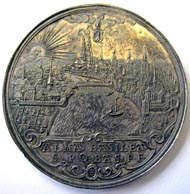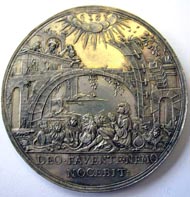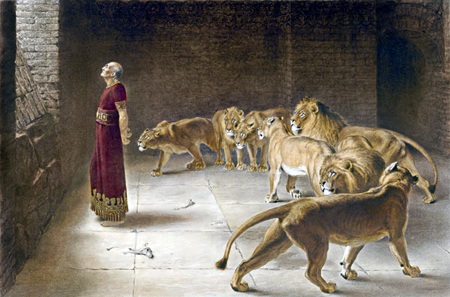At the end of the Thirty Years War which the Swiss notoriously had not joined in, this splendid medal was made by Friedrich Fecher by order of the government of Basel.
Basel. Medal (43.02 g) without year (c.1645) by F. Fecher. City view at sunrise, above Basel shield hold by the hand of God, in the exergue a decorated field bearing the inscription: ALMA BASILEA / SPQ BAS FF, FF (as monogram). Rv. DEO FAVENTE NEMO / NOCEBIT Prophet Daniel in the lion’s den, on his left, king Darius on a balcony between two women (Ewig 803; Haller 1335; Wund. 2185; Leu SM 1052). Copyright Sturzenegger Stiftung / Museum zu Allerheiligen Schaffhausen.
Friedrich Fecher was a native of Strasbourg, where a guild’s list records his name besides the year 1612 and his sign: two F closely put together in a Renaissance shield. Precisely the same sign appears on our medal: below the cartouche with the city name we can see a small shield with the artist’s initials. Fecher came to Basel in 1640. Apparently without being member of any guild in Basel he produced and sold silver and gold implements. Hence the gold and silver guild’s smiths complained about his black labor and achieved finally that he was prohibited to do any more gold and silver work. However, he was able to continue his career as a medal die cutter. To that permission we owe this gorgeous Renaissance medal showing prophet Daniel in the lion’s den.
Briton Rivière (1840-1920), Daniel’s answer to the king. Source: Wikipedia Commons.
According to the Bible (Dan. 6, 6-29) Daniel was a highly respected official at the court of king Darius. Since other people begrudged him his influence they induced the monarch to prohibit addressing any requests to other persons than to the king personally. In case of infringement the delinquent was to be thrown in the lion’s den. Daniel trespassed this order due to his habit of preaching every day three times to his God. Naturally the initiators of this law spied on him and reported on his transgression to the king. Thus the king had no alternative to throwing loyal Daniel into the lion’s den. He waited until sunrise then he ordered the prophet to be closed into the compound. The following morning the king rushed to the den. And it is exactly that moment we can see on the medal. Darius with his crown stands in the middle of two women on a balcony looking down on Daniel. Daniel had been spared by the lion’s thanks to his prayers. God’s name written in Hebraic letters on the clouds at the upper edge watches over everything, behind it the rays of the sun are rising.
The other side of the medal gives the key to understand the idea of that image. We see quite an uncommon view on the city of Basel at sunrise. Instead of putting the bastions of the old quarter (‘Kleinbasel’) in the foreground and the Basel Münster in the centre, the river had received special attention by depicting it in the foreground. Above this scenery God’s hand extends out of the clouds holding tight the city’s arms. Thus it is as the device of the other side declares: ‘Those towards whom God is inclined cannot be wrecked by anyone.’






